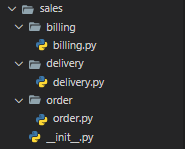Summary: in this tutorial, you learn about the Python packages and how to use them to structure your application.
Introduction to Python packages #
Suppose that you need to develop a large application that handles the sales process from order to cash.
The application will have many modules. When the number of modules grows, it’ll become difficult to keep all of them in one location.
And you may want to group modules into something meaningful.
This is where packages come into play.
Packages allow you to organize modules in the hierarchical structure.
The way Python organizes packages and modules like the Operating System structures the folders and files.
To create a package, you create a new folder and place the relevant modules in that folder.
To instruct Python to treat a folder containing files as a package, you need to create a __init__.py file in the folder.
Note that starting with Python 3.3, Python introduced the implicit namespace packages feature. This allows Python to treat a folder as a package without the __init__.py.
For example, the following picture shows the sales package that contains three modules including order, delivery, and billing:

Importing packages #
To import a package, you use the import statement like this:
import package.moduleCode language: Python (python)And to access an object from a module that belongs to a package, you use the dot notation:
package.module.functionCode language: Python (python)The following shows how to use functions in the order, delivery, and billing modules from the sales package:
# main.py
import sales.order
import sales.delivery
import sales.billing
sales.order.create_sales_order()
sales.delivery.create_delivery()
sales.billing.create_billing()Code language: Python (python)To make the code more concise, you can use the following statement to import a function from a module:
from <module> import <function>Code language: Python (python)For example:
# main.py
from sales.order import create_sales_order
from sales.delivery import create_delivery
from sales.billing import create_billing
create_sales_order()
create_delivery()
create_billing()Code language: Python (python)It’s possible to rename the object when importing it:
# main.py
from sales.order import create_sales_order as create_order
from sales.delivery import create_delivery as start_delivery
from sales.billing import create_billing as issue_billing
create_order()
start_delivery()
issue_billing()Code language: Python (python)In this example, we rename…
- The
create_sales_ordertocreate_order, - The
create_deliverytostart_delivery, - and the
create_billingtoissue_billing.
Initializing a package #
By convention, when you import a package, Python will execute the __init__.py in that package.
Therefore, you can place the code in the __init__.py file to initialize package-level data.
The following example defines a default tax rate in the __init__.py of the sales package:
# __init__.py
# default sales tax rate
TAX_RATE = 0.07Code language: Python (python)From the main.py file, you can access the TAX_RATE from the sales package like this:
# main.py
from sales import TAX_RATE
print(TAX_RATE)Code language: Python (python)In addition to initializing package-level data, the __init__.py also allows you to automatically import modules from the package.
For example, in the __init__.py, if you place the following statement:
# __init__.py
# import the order module automatically
from sales.order import create_sales_order
# default sales tax rate
TAX_RATE = 0.07Code language: Python (python)And import the sales package from main.py file, the create_sales_order function will be automatically available as follows:
# main.py
import sales
sales.order.create_sales_order()Code language: Python (python)from <package> import * #
When you use the statement to import all objects from a package:
from <package> import *
Code language: Python (python)Python will look for the __init__.py file.
If the __init__.py file exists, it’ll load all modules specified in a special list called __all__ in the file.
For example, you can place the order and delivery modules in the __all__ list like this:
# __init__.py
__all__ = [
'order',
'delivery'
]
Code language: Python (python)And use the following import statement in the main.py:
# main.py
from sales import *
order.create_sales_order()
delivery.create_delivery()
# cannot access the billing module
Code language: Python (python)From the main.py, you can access functions defined in the order and delivery modules. But you cannot see the billing module because it isn’t in the __all__ list.
Subpackages #
Packages can contain subpackages. The subpackages allow you to further organize modules.
The following shows the sales package that contains three subpackages: order, delivery, and billing. Each subpackage has the corresponding module.
For example, you can place all other modules related to the order processing in the order subpackage:

Everything you’ve learned about packages is also relevant to subpackages.
For example, to import a function from the order subpackage, you use the following import statement:
# main.py
from sales.order import create_sales_order
create_sales_order()Code language: Python (python)Summary #
- A Python package contains one or more modules. Python uses the folders and files structure to manage packages and modules.
- Use the
__init__.pyfile if you want to initialize the package-level data. - Use
__all__variable to specify the modules that will load automatically when importing the package. - A package may contain subpackages.